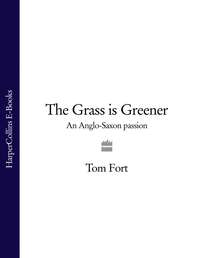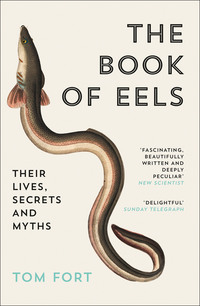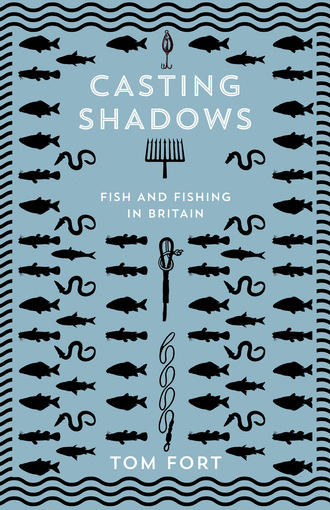
Полная версия
Casting Shadows

CASTING SHADOWS
FISH AND FISHING IN BRITAIN
Tom Fort

Copyright
William Collins
An imprint of HarperCollinsPublishers
1 London Bridge Street
London SE1 9GF
WilliamCollinsBooks.com
This eBook first published in Great Britain by William Collins in 2020
Copyright © Tom Fort 2020
Images copyright © individual copyright holders
Tom Fort asserts the moral right to be identified as the author of this work.
A catalogue record for this book is available from the British Library.
All rights reserved under International and Pan-American Copyright Conventions. By payment of the required fees, you have been granted the non-exclusive, non-transferable right to access and read the text of this e-book on-screen. No part of this text may be reproduced, transmitted, down-loaded, decompiled, reverse engineered, or stored in or introduced into any information storage and retrieval system, in any form or by any means, whether electronic or mechanical, now known or hereinafter invented, without the express written permission of HarperCollins.
Source ISBN: 9780008283445
eBook Edition © April 2020 ISBN: 9780008283469
Version: 2020-03-02
Dedication
For my two fishing brothers, James and Matthew,
who first showed me the path to the water.
Contents
Cover
Title Page
Copyright
Dedication
Introduction
1. In from the Sea
2. Night Harvest
3. A Passion for Ponds
4. An Angle on Fishing
5. Fur and Feather
6. The Ascendancy of the Laird
7. For the Masses
8. Salmon on Ice
9. A Gentlemen’s Club
10. Wye Wizardry
11. While Life Lasts
12. Salmon Plunder
13. Vanishing Act
14. Death and Transfiguration
15. Growing Up
16. The Spring
Epilogue
Appendix: All the Fishes
Footnotes
Bibliography
Image Credits
Index
Acknowledgements
About This Book
About the Author
About the Publisher
Introduction
As the tide ebbs the netsman stands on the sandbar, ‘the place’ as he calls it. The water, thick with sediment, is above the knee seams of his chest waders, pushing insistently at his legs. He scans the smooth water, searching for the mark, where the surface is furrowed by a salmon finding its way upstream.
The waiting and watching begin when the falling tide makes it possible to reach the place. The fisherman wants calm weather, to aid visibility. Too much wind is bad, rain is bad. He needs to be able to scan the surface intently. Then he sees it, a ‘V’ parting the smoothness. He moves fast but without hurry. He knows from experience that as long as the fish does not detect his presence, it will move steadily up against the flow, holding its course.
He wades just faster than the tide, so that he leaves no wake. The net, shaped like a great ‘Y’, looks cumbersome. But he handles it with ease, leaning it against his shoulder as he moves, then extending it where he judges he is intercepting the salmon’s course.
He braces himself against the rush of the stream. Behind him, across the width of the river, the water is draining seawards. It pushes itself across the bars and banks of sand, seeking the channels, surging and seething in its haste, setting up a dry, insistent, rustling sound, ‘the ruts’, the fisherman calls it. He is intent on the one channel, where the fish run.
He can see nothing in the brown water, but he has followed the mark as the back of the fish steals upstream, and he knows it is close. The net is thrust out before him and his hands are firm on the ash staff. He dips it down then sweeps the frame up. There it is, like a flash of silver light or a sunbeam, but solid flesh and muscle, twisting and kicking against the mesh. He reaches for his knobbling pin, a short, heavy stick, smooth and with a slightly rounded head, and strikes the fish hard at the back of its head. Its life journey, which began on a bed of gravel on one of the nameless spawning streams that form the headwaters of this river – the same nameless stream it is seeking today – is over.

Mike Evans, one of the last of the Severn lave netsmen.
Tom Fort
The implement described is known as a lave net. The origin of the word ‘lave’ is unknown, and its use in this country has been restricted to sections of the Severn estuary where the movements of the tides and the accessibility of sand and mud banks with deeper channels between made it effective. But the principle behind it is universal. The great ethnographer James Hornell – who studied ancient fishing methods in all parts of the world – found a fairly exact version of the lave net in use on the lower Ganges in Bengal,[fn1] the one significant difference being that the mesh was made from bamboo mat instead of cord or thread.
Across the world prehistoric societies exploited the rich food source available in lakes, rivers, estuaries, lagoons and along shorelines. They trapped, netted, speared, noosed, stunned, tickled and lured every species of fish they could find. The methods they used evolved in response to particular circumstances. But – as with the lave net – the responses were often very similar because the circumstances do not vary that much. James Hornell, travelling and inquiring among what were still primitive and isolated communities at the end of the nineteenth century and into the 1930s, described many of these methods in his indispensable Fishing in Many Waters. He was able, for instance, to observe Chinese and Japanese fishermen deploying trained cormorants to catch fish on the Yangtze and Nagara rivers; and the use of toxic plants to stupefy fish in a lagoon in Fiji and in pools on the Benue River in northern Cameroon.
It may be that these techniques were used somewhere in the British Isles in the dim and very distant past (poisonous plants such as Verbascum phlomoides and Euphorbia villosa were still being resorted to on the Danube delta and in the Carpathian region of Romania post-1945). But if so, that use can be presumed to have lapsed well before the start of what we regard as recorded history. So for knowledge, we depend on remnants. Once we have those, it becomes possible to reconstruct what they formed part of, what that implement was used for, and how and when.
The oldest known fish traps in Europe go back 7,000 years to the Mesolithic era, examples of which have been discovered as far afield as Ireland, Denmark and Russia. The earliest confirmed trap in Britain, at Cold Harbour Pill on the western side of the Severn estuary near Newport, has been carbon-dated to the late Bronze Age (perhaps 1200 BCE). These and other prehistoric structures revealed their existence because the wooden posts and other materials used can survive many centuries if buried or half buried in mud. Archaeologists love them, because they represent fact, data, proof. The fact that visually these pieces of blackened wood and fragments of basketwork are extremely unexciting matters not at all. They can be photographed, subjected to carbon dating, minutely described and compared with equally unexciting bits-and-bobs from elsewhere to build timelines and arching narratives, thereby justifying the whole laborious process of discovery and excavation.
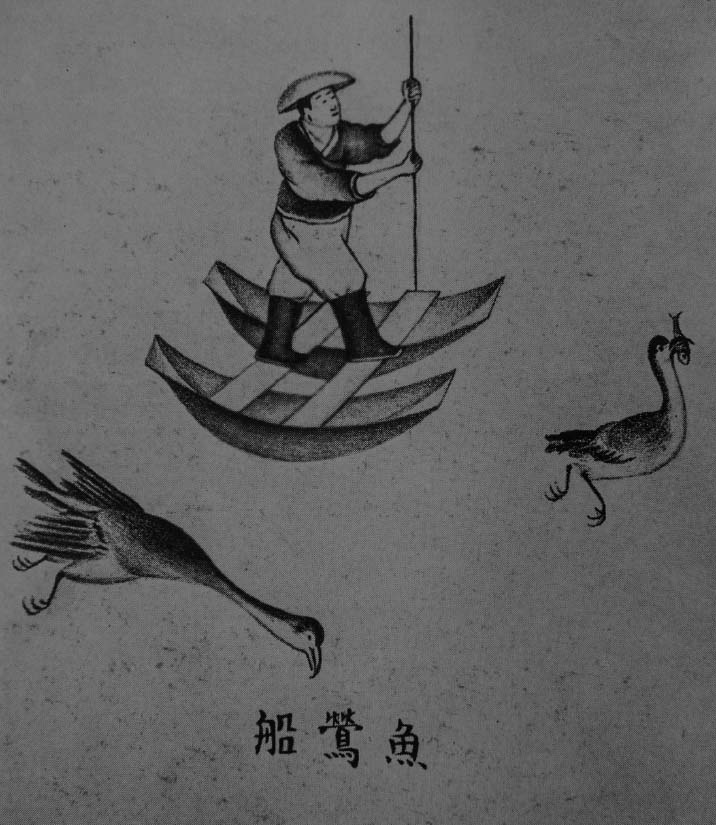
A Chinese illustration of cormorant fishing, 1872.
La Pisciculture et la Peche en Chine by Dabry de Thiersant, published by Masson in Paris, 1872
But these finds are not the story. The fish trap at Cold Harbour Pill on the Severn represents one point in a timeline extending long before and long after. It was preceded by other devices installed for the same purpose – to intercept fish, chiefly salmon, eels and shad – so that they might be killed and eaten by the communities that managed the trap, or traded and bartered by them for other needs. It was followed by other traps used for the same purpose. Two thousand years later the same principle was being followed in both sides of the estuary in the form of fixed ranks of baskets known as putchers or putts – more elaborate, more time-consuming to construct and maintain, more effective in terms of fish caught, but essentially no different. These survived until living memory, when the sudden collapse in salmon abundance put them out of business.
There were two terms in Anglo-Saxon for these fixed traps – haecwer and cytweras, meaning fish weir and fish weir with baskets. The concept would have been recognisable the world over: a V-shaped barrier on a gently shelving stretch of foreshore covered and uncovered by the tides, generally facing upstream to take fish that moved in with the flood and dropped back on the ebb, with a net or basket at its apex. In London the remains of fish weirs of this type have been uncovered close to the banks of the Thames at several locations including Chelsea, Vauxhall, Isleworth, Kew, Hammersmith and Brentford. The arms consisted of wattle hurdles fixed between oak or elm posts, and the apex trap was made of woven willow. Carbon analysis dates them to between 650 and 890 CE – but, again, it is certain that traps of a similar design would have been in use in roughly the same locations – generally across a channel between the shore and a sandbank or mudbank or an eyot, a river island – going back to the earliest human occupation.
By its nature a fixed trap is only effective in catching migrating fish – primarily salmon and eels (although on the Severn lampreys and shad came into the equation as well). In tidal waters Atlantic salmon returning from the sea to spawn in their birth rivers move up with the incoming tide and drop back on the ebb, biding their time until the river flow is strong enough for a decisive move upstream. Eels are intent on an opposite path. In autumn, in high water and in stormy conditions, they forge their way downstream seeking the open sea and – eventually – the immensely far distant Sargasso, where they mate and die. The migratory impulses of both salmon and eels means that they are also vulnerable to exploitation at any point in fresh water, from nets and other kinds of traps, as well as spearing, snagging and – in the case of eels – being caught on bait.
Prehistoric communities adopted multiple strategies for survival. Along the Severn shore Megalithic men, women and children left their footprints in the mud, alongside those of wolves, aurochs and birds. They grazed their animals, panned salt, hunted and devised various ways to catch fish. Some of their methods lapsed with them, others survived into the era of written record, evolving along the way. Some – but not all – even survived into our time. On the tidal Thames, for instance, the fixed shoreline traps of Anglo-Saxon times fell into disuse or were dismantled in the medieval period because they interfered with a more pressing requirement, navigation. But on the weirs that were built upstream to accompany the navigation locks, traps for migrating eels – known as eel bucks – were in use until the end of the nineteenth century.
For most of our history we have been untroubled by the notion of sustainability or the concept of a need to conserve natural resources. People helped themselves to fish by whatever means the available materials and their resourcefulness made possible. Generally, the abundance was such that they could not imperil its future. Fishing was a matter of life for societies living or maintaining seasonal camps by the water, and death for the fish. Later it evolved into a business, the fish into a commodity. Expanding markets and more sophisticated methods enabled an ever-increasing proportion of the resource to be exploited. But as recently as the second half of the nineteenth century the respected authorities who advised the government on fisheries policy were continuing to assert that the abundance of fish of all species was such that it could never be overexploited – that the very idea of overfishing was flawed. It is only over the past century that the full extent of that disastrous misinterpretation has been exposed.
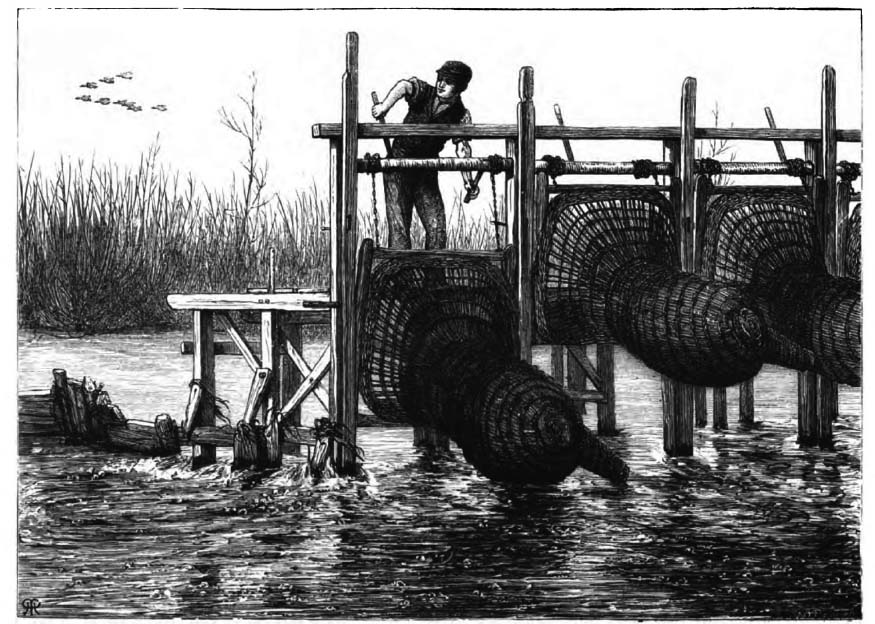
Lowering eel bucks on the upper Thames, 1875.
Life on the upper Thames by H.R. Robertson, published by Virtue, Spalding, and Co in London, 1875. Sourced from Archive.org, Harvard University
In 1976 – when I was twenty-five years old – that lave netsman on the Severn caught and killed and sold more than three hundred salmon during the season. Twenty-six of them he netted on a single tide. He made more money that year from salmon than he did from his full-time job in a factory in Gloucester.
For the season of 2018 his licence allowed him to take one fish, which he did one day in August on the great horseshoe bend upstream from Newnham. He took it, not to sell or trade, but just to demonstrate that the tradition in which he grew up and plied his craft is not yet dead. Maybe not, but it is dying and nothing can save it. The salmon still come, but the scale of the run has diminished from a steady stream to a trickle, to the point that those charged with safeguarding what is left have decreed that no significant exploitation can be permitted. The netsman I have described at work is now eighty years of age; within a few years there will be none left.
In January 2019 the commercial fishery for wild salmon on the north-east coast of England, using fixed nets on the shore, ceased operations after the Environment Agency announced it would no longer give licences to the handful of remaining netsmen. It was the last significant wild salmon fishery in Britain. The relentless decline in the numbers of salmon returning to these shores from their North Atlantic feeding grounds had finally forced the hand of the authorities. What Thomas Huxley and those other Victorian experts had asserted could not happen – and which had already happened to herring, cod and plaice at sea – had now happened to the salmon, our most valuable and charismatic freshwater fish. The reasons for that collapse continue to be argued over. What is certain is that the exploitation of the species for food for us – which has lasted for millennia, sustained communities and local economies, and nourished a rich heritage and store of knowledge – is finished. And barring a cataclysm that brings about a reversion to a hunter/gatherer existence, it will never return.
The harvesting of our other main fish-as-food freshwater species – the eel – is going the same way. As a commodity it was never as important as salmon, but it was systematically exploited in those parts of the country where it thrived – chiefly East Anglia, the Somerset Levels and the Severn system – and was traded in significant volume at the Billingsgate Market in London. Its popularity as a food item in Britain waned some decades ago (although it is still warmly favoured in much of continental Europe). Over roughly the same period there has also been a sustained fall in eel populations across Europe, causing it to be declared an endangered species. Fishing for adult wild eels – always a localised, low-level and marginal activity – has declined almost to vanishing point. The Environment Agency now follows a policy of issuing licences only to existing fishermen, thereby virtually guaranteeing that eel fishing will die out within a generation.
Now is a suitable time to look at the very long history of how we have made use of our freshwater fish as a source of protein – a history that has not been celebrated, nor even hardly told, because fish are fish and not much regarded by society at large. But there is another dimension to this story of the fish of our rivers, streams, brooks, becks, burns, lakes, lochs, loughs, meres, ponds, canals, estuaries and other assorted waters. There has been a third stage in the evolution of our relationship with them, one that is far from finished. First, it was a matter of fishing to eat and survive. Second, the need to fish became a business and the fish a trading commodity. Later still – but not that much later – the business gave birth to a desire to pursue, outwit and catch the fish for the pleasure of it. This is what we called angling.
This birth was one minor aspect of that Middle Ages blossoming of the human spirit that embraced writing, painting and other visual arts, dress, manners, chivalry, philosophy, scientific inquiry – the notion (among the privileged few) that there should be more to life than merely the struggle, often unavailing, to maintain it. But how did that refinement, fishing for fun, evolve from the business?
There are places and circumstances in which a net or trap or spear is not so much inefficient as useless. But you might still want a fish to eat – a trout, say, feeding in fast water, or a pike lurking by a reedbed. Then the rod (or angle, hence angling) comes into its own. It is a uniquely effective way of delivering a bait or lure to a particular spot for a particular fish. That is what the Roman historian Claudius Aelianus, in the first recorded reference to angling, described the Macedonians as doing on the River Astraeus around 200 CE – deploying a rod and an artificial fly to catch ‘fish with speckled skins’.
Those Macedonians were definitely not motivated by a sporting impulse. They devised (or maybe borrowed) the technique because they worked out that this was the best way to catch the trout they wished to eat. In time, that desire – I am surmising here, but what other answer is possible? – became tinged by another, more subtle emotion, excitement. And the excitement was followed by another, the pleasure in success (and its antithesis, bitter disappointment).
Thus angling grew into a diversion, a sport. It beguiled poets and painters and philosophers, soldiers, statesmen and scientists. In time it embraced the Sheffield knife-grinder eager to escape from his poisoned city to a quiet bend on the river in the countryside where he might watch his float in peace. It embraced the highborn Scottish aristocrat, descended from Highland land-grabbers, lording it over his river and jealously watching over the silver salmon as they came in from the sea. It entranced film stars, dictators, American presidents and British prime ministers, terrorists, murderers. It touched all classes of men and women, who found that – if they had nothing else in common – they shared this passion to feel a fish on the end of their line.
It is no coincidence that Jesus should have recruited four fishermen – the brothers Simon (called Peter) and Andrew, and the brothers James and John – as his first disciples, to make them fishers of men. In their first calling they required particular qualities: patience, of course, resilience in the face of adversity and disappointment, endurance, determination, courage, versatility. These were qualities that would stand them in good stead in their second calling.
They would also have learned from their fishing that the important things seldom come quickly. They would have learned to take their time, to be aware of what lies beneath the surface, to know that there is always more to know and that learning is never complete. Peter and Andrew and James and John and all the fishermen and women before and after them have been bound together in sympathy for the element of water and the life it sustains – ‘the mythic plane’, as the poet Ted Hughes called it. For Hughes the acquisition of polaroid glasses was a revelation, enabling him to penetrate that plane to a degree. But even with the glasses no one can see it all. The picture must be filled in as far as possible by intuition, experience, understanding, and the exercise of the imagination.
The water lover – often an angler – will deploy those slowly acquired skills to grasp the wholeness of the life above, on and beneath the surface. It is a complex entity. There is movement, stillness, clarity, obscurity, light, darkness, depths, shallows. There are plants: willows, alders, reeds, sedges, flag irises, ranunculus, ribbon weed, tough-stemmed water lilies. There is the insect life: water boatmen, damselflies, a host of invertebrates. There are frogs, snails, newts, coots, ducks. And there are the fish. The water lover will have an apprehension of all that, and those who do not share that sympathy will know very little and hardly understand what they are missing.
The passion gripped me when I was a boy. More than sixty years later I am still gripped by it, although the focal points have changed somewhat over the intervening period. The mind and imagination of my eight-year-old self were concentrated on the bright orange top of my float, the pink worm suspended unseen below, my savage longing for the float to tremble, glide away, disappear, and for the upward lift of my rod tip to be answered by the desperate, vital resistance of a perch. Now, as I write these words on a morning in early June, I picture a minute chalkstream threading its way through rough meadows grazed by black cattle, mayfly air-dancing in search of mates in the shade of the hawthorn or veering towards the water to lay their eggs, wild brown trout on station above the golden gravel ready to raise a snout and intercept the struggling prey.
What has not changed at all is the sense of fulfilment that comes from studying and deepening my understanding of the medium of water, still or moving. I have spent a significant proportion of my years on, beside or in fresh water. The declared purpose has always been to catch a fish. But I recognise that operating beneath that purpose has been an inexhaustible inquisitiveness about the wholeness of the watery sphere and how it nourishes itself, how the many communities of life forms within it fit together and how we – its custodians and exploiters – relate to it.
For many years I wrote copiously about angling, until I found that I had pretty much said all I had to say and was beginning to repeat myself. I wrote on other subjects instead, while occasionally yielding to a weakness for introducing watery or fishy matters into other contexts. I always had in the back of my mind the awareness that one day I would come back to what has been one of the determining impulses of my life; and try to pull together in a single narrative everything (or almost everything, because some of its inevitably gets left out) about it that I had learned from experience and study and reading and talking to others, and from thinking and letting my imagination work. This is that narrative. I hope that it expresses something of the gratitude I feel for the way in which our waters and their creatures have enriched my life and the lives of countless others.
CHAPTER ONE
In from the Sea
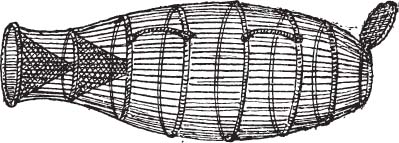
The old grey town of Dingwall stands near the head of the Cromarty Firth, a few miles north of Inverness. It was a place of some importance once, one of the royal burghs and the county town of Ross and Cromarty. Although it was never wealthy, the leading townspeople who sat on its council took their duties seriously. Despite being a mile or so from the shore of the firth, it had a harbour of sorts and the council had ambitions to expand its sea trade. To that end it commissioned the most celebrated engineer of the age, Thomas Telford, to upgrade the River Peffery – actually no more than a stream – into a splendid canal that would connect Dingwall with its harbour and allow cargo boats to unload and load near the centre of town.




